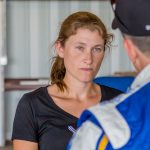
OCEAN PINES – A recently completed reserve study is expected to help the Ocean Pines Association plan for the future.
On Friday the Ocean Pines Association (OPA) board of directors joined members of the association’s budget and finance committee to review a reserve study completed by DMA Reserves. The study looks at the association’s current level of reserve funding, its amenities and its future funding needs.
“Keep in mind this is a planning tool,” said Doug Greene, a representative from DMA Reserves. “It’s not a prescriptive plan telling the association what to do when.”
At the start of Friday’s meeting, OPA General Manager John Bailey explained that Greene would be reviewing the process behind the study. The actual numbers in the study, he said, were still being discussed by the budget and finance committee, which would provide the board with specific recommendations in the coming weeks.
“I’ve been pitching for this meeting for a long time and how important it is for everybody to grasp this concept,” Bailey said. “This is one major piece to what we do as an association.”
According to Greene, the reserve study was broken down into three areas — a general reserve account, a bulkhead reserve account and a third account focusing on roads and bridges.
“The intent of the reserve study is to project all of the long-term costs that are involved,” Greene said.
Greene said the study included information on each of the association’s amenities, from items such as the components at each place — things like the rubber matting and joint caulk at OPA pools — to the expected lifespan and cost to replace those components.
“It’s a 30-year study,” he said. “Years one through five you have a pretty good handle on. Years 25 to 30 are pretty speculative.”
Greene said that theoretically, under what is known as the component funding method, replacing each and every one of OPA’s numerous components would cost $19 million. The association currently has $4.5 million in its reserve accounts, which would mean the association is about 24 percent funded. Greene said that most homeowners associations were between 50 and 75 percent funded, but stressed that he discounted the component funding method for the most part.
“Component method funding is the way all reserve studies used to be done years back,” he said. “Maybe 15 to 20 years ago a bright guy introduced a different way to do this and that’s the cash flow method. That’s the method we use in projecting your needs here.”
He said he only shared the component method funding numbers to provide the association with a snapshot of its reserve account at this point in time.
Greene added that if OPA didn’t increase its reserve contribution over time, its reserve account would eventually fall below zero.
“Inflation eats the money,” he said. “You have to keep up with it. Things are going to cost more in the future.”
While some asked what sort of annual assessment increase it would take to fund the rising cost of inflation, John Viola, chair of the budget and finance committee, said that figure hadn’t yet been determined.
“We’re still vetting out the detail that goes into the calculation,” he said. “Numbers could change a little bit.”
Resident Dick Neiman asked how the study and its breakdown of components would serve the association better than depreciation.
Greene said depreciation—the practice of allocating the cost of an asset over its useful life—was an accountant’s term.
“It doesn’t mean the reserve component will last that long,” he said. “We’re trying to deal with what we expect will really happen over time.”
Resident Pete Gomsak, a former board member, said OPA had historically funded depreciation.
“Over time Ocean Pines got itself in rather a pickle because of this concept,” he said. “What happened was this concept of funding depreciation did not have an inflation factor in it.”
He said that when the community center needed to be replaced several years ago, the fully depreciated cost of the building — what OPA had saved to replace it — was $363,000. The actual cost of replacing the building, however, was close to $2 million.
Resident Joe Reynolds said the question of how much money to set aside in the reserve account was a political issue.
“This board has to make a political decision on how much money it wants to take from association members for reserves,” he said.
Greene stressed that he wasn’t suggesting that the association needed the $19 million called for by the component funding method. He said it wasn’t a reliable method of predicting the association’s need. Board member Ted Moroney agreed.
“We’re not using the percentage funding as we go forward,” he said. “We’re going to use a threshold and a five-year cash flow need. We’re not going to say we’ve got to be at 75 percent (funded). Everybody should be clear on that.”
Moroney stressed that the association would be establishing a reserve funding threshold and a contribution rate and would incorporate inflation into its long-term funding plan. He said talk of the component funding method simply confused the reserve issue in Ocean Pines.
“That’s great if we’re just starting, but it’s very difficult at this point to go from $4 million to $17 million,” he said. “It’s just not going to happen.”
Reynolds maintained that the average association member simply wanted to know how much their annual assessment would be increasing.
“As soon as the recommendation comes back from budget and finance we’ll be able to plug it in and say it,” Moroney said.
Viola said the budget and finance committee would spend the coming weeks reviewing the study.
“Budget and finance will be pondering everything that was brought forth today,” he said.

